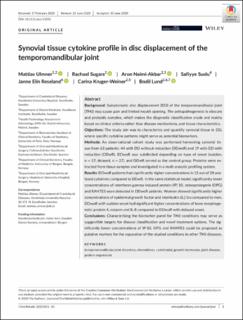| dc.contributor.author | Ulmner, Mattias | |
| dc.contributor.author | Sugars, Rachael | |
| dc.contributor.author | Naimi-Akbar, Aron | |
| dc.contributor.author | Suslu, Safiyye | |
| dc.contributor.author | Reseland, Janne Elin | |
| dc.contributor.author | Kruger-Weiner, Carina | |
| dc.contributor.author | Lund, Bodil Kristina | |
| dc.date.accessioned | 2021-04-30T07:47:12Z | |
| dc.date.available | 2021-04-30T07:47:12Z | |
| dc.date.created | 2020-07-07T12:09:24Z | |
| dc.date.issued | 2020 | |
| dc.Published | Journal of Oral Rehabilitation. 2020, 47 (10), 1202-1211. | |
| dc.identifier.issn | 0305-182X | |
| dc.identifier.uri | https://hdl.handle.net/11250/2740480 | |
| dc.description.abstract | Background
Symptomatic disc displacement (DD) of the temporomandibular joint (TMJ) may cause pain and limited mouth opening. The aetiopathogenesis is obscure and probably complex, which makes the diagnostic classification crude and mainly based on clinical criteria rather than disease mechanisms, and tissue characteristics.
Objectives
The study aim was to characterise and quantify synovial tissue in DD, where specific cytokine patterns might serve as potential biomarkers.
Methods
An observational cohort study was performed harvesting synovial tissue from 63 patients: 44 with DD without reduction (DDwoR) and 19 with DD with reduction (DDwR). DDwoR was subdivided depending on type of onset (sudden, n = 17; delayed, n = 27), and DDwR served as the control group. Proteins were extracted from tissue samples and investigated in a multi‐analytic profiling system.
Results
DDwoR patients had significantly higher concentrations in 12 out of 28 analysed cytokines compared to DDwR. In the same statistical model, significantly lower concentrations of interferon gamma‐induced protein (IP) 10, osteoprotegerin (OPG) and RANTES were detected in DDwoR patients. Women showed significantly higher concentrations of epidermal growth factor and interleukin (IL) 1ra compared to men. DDwoR with sudden onset had significant higher concentrations of bone morphogenetic protein 4, eotaxin and IL‐8 compared to DDwoR with delayed onset.
Conclusions
Characterising the biomarker panel for TMJ conditions may serve as suggestible targets for disease classification and novel treatment options. The significantly lower concentrations of IP‐10, OPG and RANTES could be proposed as putative markers for the separation of the studied conditions to other TMJ diseases. | en_US |
| dc.language.iso | eng | en_US |
| dc.publisher | Wiley | en_US |
| dc.rights | Attribution-NonCommercial-NoDerivatives 4.0 Internasjonal | * |
| dc.rights.uri | http://creativecommons.org/licenses/by-nc-nd/4.0/deed.no | * |
| dc.title | Synovial tissue cytokine profile in disc displacement of the temporomandibular joint | en_US |
| dc.type | Journal article | en_US |
| dc.type | Peer reviewed | en_US |
| dc.description.version | publishedVersion | en_US |
| dc.rights.holder | Copyright 2020 The Authors | en_US |
| cristin.ispublished | true | |
| cristin.fulltext | original | |
| cristin.qualitycode | 2 | |
| dc.identifier.doi | 10.1111/joor.13051 | |
| dc.identifier.cristin | 1818815 | |
| dc.source.journal | Journal of Oral Rehabilitation | en_US |
| dc.source.40 | 47 | |
| dc.source.14 | 10 | |
| dc.source.pagenumber | 1202-1211 | en_US |
| dc.identifier.citation | Journal of Oral Rehabilitation. 2020, 47 (10), 1202-1211. | en_US |
| dc.source.volume | 47 | en_US |
| dc.source.issue | 10 | en_US |

